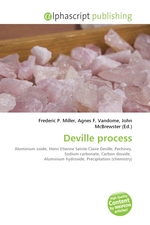Deville process
Frederic P. Miller, Agnes F. Vandome, John McBrewster
бумажная книга
Please note that the content of this book primarily consists of articles available from Wikipedia or other free sources online. The Deville process was the first industrial process used to produce alumina from bauxite. The Frenchman Henri Sainte-Claire Deville invented the process in 1859. It is sometimes called the Deville-Pechiney process. It is based on the extraction of alumina with sodium carbonate. The first stage is the calcination of the bauxite at 1200°C with sodium carbonate and coke. The alumina is converted in sodium aluminate. Iron oxide remains unchanged and silica forms a polysilicate. In the second stage sodium hydroxide solution is added, which dissolves the sodium aluminate, leaving the impurities as a solid residue. The amount of sodium hydroxide solution needed depends upon the amount of silica present in the raw material. The solution is filtered off; carbon dioxide is bubbled through the solution, causing aluminium hydroxide to precipitate, leaving a solution of sodium carbonate. The latter can be recovered and reused in the first stage.
Данное издание не является оригинальным. Книга печатается по технологии принт-он-деманд после получения заказа.


